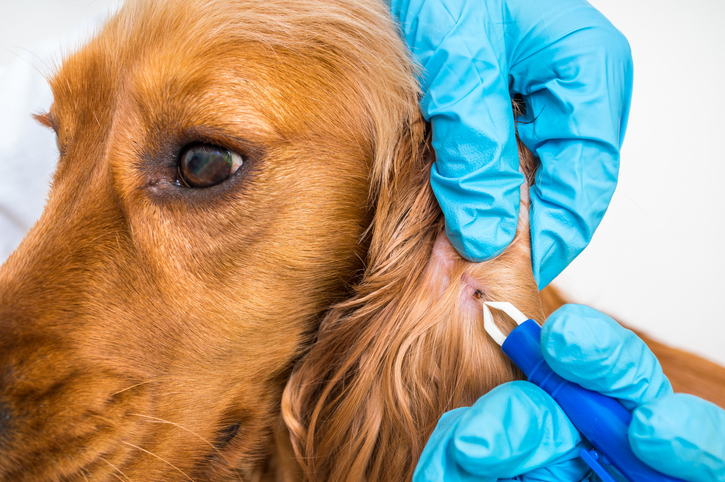If you know dogs, then you’re probably familiar with fleas: the pesky pests that are the bane of pet owners everywhere. These tiny, blood-sucking insects aren’t a huge threat on their own. But when enough of them settle amidst a cat or dog’s fur, it can quickly become an infestation, leading to problems and discomfort for pets and their owners alike.
Fleas naturally come from outside, where they may jump onto a dog while they’re on a walk, then hitch a ride back to your house. For dogs that spend lots of time outside, flea prevention is a no-brainer. But what if your dog spends most of its day inside the home?
As it turns out, flea prevention is absolutely vital for all dogs, regardless of where they spend the bulk of their day. But before we can understand why prevention is so important, let’s learn a little more about fleas.
What You Need to Know About Fleas
As we mentioned, fleas are tiny, parasitic insects that like to nestle into the dense fur of cats, dogs, and certain other animals. They breed on the hair, with populations exponentially growing and potentially reaching the thousands within just a few weeks or months. The fleas will then live off of the animal’s blood, perpetually feeding and breeding for as long as they can.
Besides the unsettling image of bugs all over your beloved pet, fleas create other problems for pets and their owners. The bites are itchy and uncomfortable (and there are usually lots of them), and they don’t just bite animals. While fleas almost never settle on humans, they have no problem taking a bite here and there.
Furthermore, fleas can transmit certain diseases and health issues to pets. These include:
- Tapeworms – Fleas can carry the eggs of these parasitic worms, passing them to your dog with each bite.
- Canine Bartonellosis – This flea-borne illness is caused by a germ commonly found in fleas. Symptoms can include coughing, diarrhea, vomiting, fever, and more.
- Anemia – Since fleas subsist off the blood of their host, dogs with untreated fleas can gradually feel the effects of these parasites in the form of anemia (a lack of red blood cells). This takes time to occur, but is a very real possibility for extended infestations.
As you can see, fleas pose some major hazards to dogs and their owners alike. So what’s the best way to deal with them? Thankfully, there’s a method that will allow you to sidestep almost all of these troubles with ease: preventative flea treatment.
Why is Preventative Flea Treatment Important?
Let’s say you take your dog (who hasn’t been treated for fleas) out on a walk in the nearby woods. While there, a couple of fleas spot your dog and jump into its coat. Once home, the fleas get to work on reproducing and laying dozens of eggs each and every day. Unlike other parasites, such as lice, flea eggs don’t stick to the hair, and will instead come off your dog’s coat at random, possibly depositing them throughout the house.
Fleas can remain inside the egg for up to a year, simply waiting for the right conditions to hatch and infest nearby animals. What does this mean for pet owners? It’s very, very difficult to reactively treat fleas once they’re discovered. Not only will you need to painstakingly remove the fleas and eggs from your dog, but you’ll also have to deep clean the entire house (including rugs, furniture, bedding, clothes, and everything else) multiple times to ensure all loose eggs and fleas have been eliminated.
This can be a huge ordeal, and since fleas are almost invisible, it can be easy to miss a few and realize the whole infestation has started over again. That’s why preventative flea care is the best way to deal with these pests for your pets.
Why Do Indoor Pets Need Flea Prevention?
Even if your dog or cat doesn’t spend too much time outside or in flea-heavy areas, prevention is highly recommended. Since the treatment is non-invasive, affordable, and has little to no side effects, almost all veterinarians will prescribe one of these treatments to your pet. These treatments are very effective—most will kill fleas, ticks, and lice and contact, as well as prevent eggs and pupae-stage fleas from growing.
As we mentioned, fleas don’t care to live on humans full-time, but they have no problem using them to catch a ride to a better host. It’s entirely possible for people or other animals to bring in just a couple of fleas to the home, which will then make short work of infesting your pets if they haven’t been treated for fleas.
Additionally, when you consider the fact that these treatments are easy to apply (there are topical and oral formulas which only need to be administered once a month), there’s really no reason to not provide your pet with the preventative care they need.
Unlike humans, animals can’t let us know when they’re sick, in pain, or covered in maddening insect bites. That’s why it’s up to us to address these problems ahead of time, hopefully protecting our pets from discomfort altogether. Flea prevention is just one example of how easy and effective proactive pet care can be.
Creative Commons Attribution: Permission is granted to repost this article in its entirety with credit to Hastings Veterinary Hospital and a clickable link back to this page.






